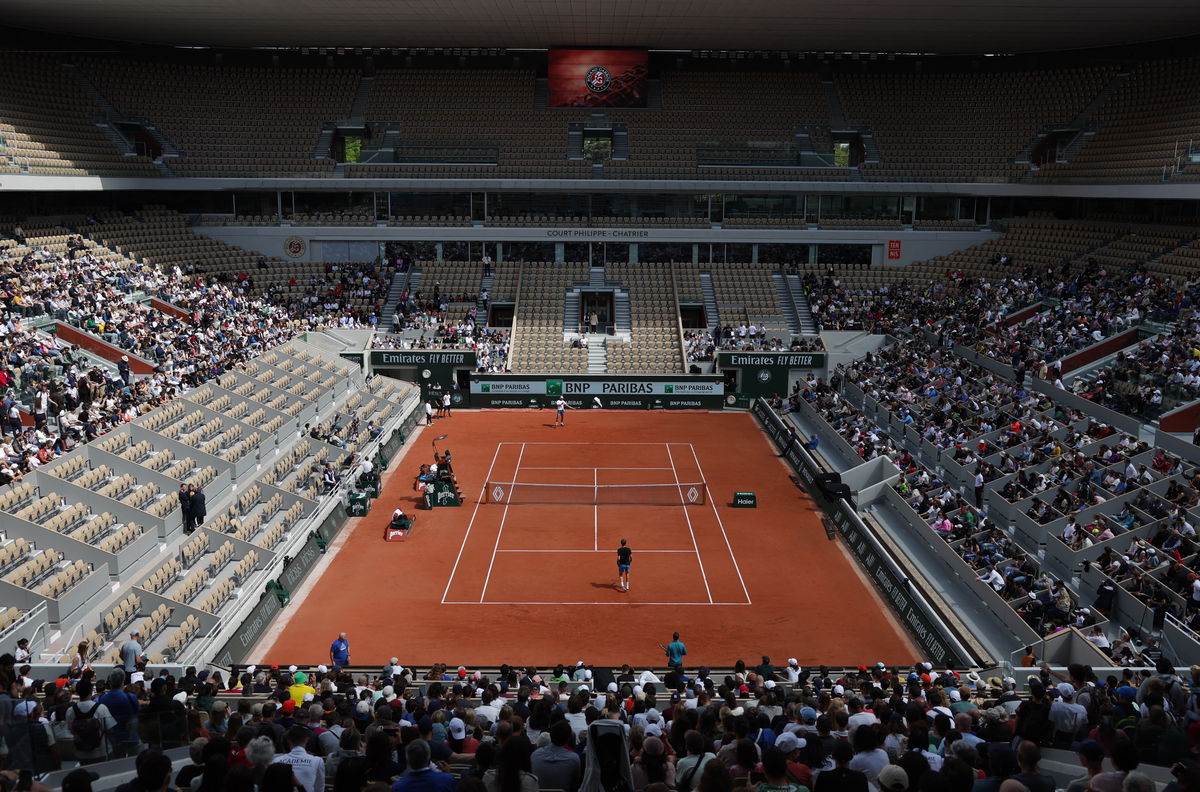
Reuters
Tennis – French Open Preview – Roland Garros, Paris, France – May 21, 2024 General view of Spain’s Rafael Nadal during a practice session ahead of the French Open REUTERS/Gonzalo Fuentes

Reuters
Tennis – French Open Preview – Roland Garros, Paris, France – May 21, 2024 General view of Spain’s Rafael Nadal during a practice session ahead of the French Open REUTERS/Gonzalo Fuentes
One of Roland-Garros’ enduring mysteries is the frequent sight of empty seats during day sessions on Court Philippe-Chatrier, which holds around 15,000 spectators. Despite the stadium being packed for iconic matches in the past — like the memorable full house when Serena Williams played during a prime-time clash at her 2013 French Open run—daytime matches often see sparse attendance. This year, the arena was packed to the brim for Rafael Nadal’s farewell ceremony. But during the matches? It’s been noticeably empty.
Watch What’s Trending Now!
Patrick Mouratoglou—who famously guided Serena for a decade—didn’t hold back about the empty stands at Roland-Garros. In a video posted on June 3, he shared, “It’s really shocking, and it’s really sad to be on Centre Court of Roland-Garros with some of the best players in the world and seeing 75, 80, sometimes 90 per cent empty, this is really shocking,” Mouratoglou said, his disbelief clear as he called out the surreal sight of world-class tennis played in front of rows of empty seats.
And while Mouratoglou might not have the “full explanation” behind why seats are empty, he believes something needs to be done, “for the players.” Further adding, “You’re at a Grand Slam, I mean, the history of tennis, one of the four more important tournaments in the world, you’re on the Centre Court, the court is empty.” But he has a theory:
ADVERTISEMENT
“One explanation that I heard — I don’t know if it’s true — is that French people are too attached to lunch from 12 to maybe four o’clock, it’s empty, and that’s a big problem,” he said. Now the French Open has scheduled its main draw matches with distinct day and night sessions. Day matches on Court Philippe-Chatrier generally begin around noon local time (CEST), often featuring three singles matches.
View this post on Instagram
However, according to him, another Grand Slam has solved this issue. He added, “The US Open has found a solution to that, at least for the VIP’s, which are the lowest seats… they put catering there. In Roland-Garros, if you want to eat, you have to go to the village. So once you’re at the village and you have the TV, you’re having a good lunch and you stay.” And it’s true.
ADVERTISEMENT
Last year, the U.S. Open saw more than one million fans pour in over three weeks, marking an impressive eight percent jump from 2023. The Main Draw alone hit a record with 832,640 attendees, setting a new high.
The buzz peaked at the men’s final, where Italy’s Jannik Sinner triumphed over American Taylor Fritz in front of a star-studded crowd — think Taylor Swift, Travis Kelce, Patrick Mahomes, Jon Bon Jovi, Matthew McConaughey, and Noah Lyles. Thousands more soaked up the atmosphere, catching celebs on the big screen and savoring $23 Honey Deuces, the Open’s signature cocktail.
ADVERTISEMENT
Not to mention, the USTA is gearing up for a massive $800 million self-funded renovation — the biggest investment in US Open history. About $550 million, or 70% of the budget, will go toward completely overhauling the interior of Arthur Ashe Stadium. The improvements will roll out in stages: new parking spaces are set to open by the 2025 tournament, courtside seats and upgraded hospitality areas will debut in 2026 (with suites and clubs still under construction), and the entire renovation is scheduled to finish in 2027.
But what about the tournament at Roland Garros? Lately, it’s not just the lack of packed crowds at the match, but also the timings that have irked many. Including the WTA World No.1, who couldn’t help but point it out.
ADVERTISEMENT
Sabalenka opens up about scheduling of the French Open
Aryna Sabalenka, sitting at the top of women’s tennis, still couldn’t escape the empty-seat blues at Roland-Garros — and she’s not happy about it. Kicking off her quarterfinal against China’s Zheng Qinwen at 11 a.m. on Court Philippe-Chatrier, Sabalenka looked out at rows of empty seats in the 15,000-capacity stadium, a scene that’s become all too common during early matches as fans trickle in late or linger over lunch.
After her 7-6 (3), 6-3 win, Sabalenka didn’t mince her words: “It was a big match and probably would make more sense to put us a little bit later just so more people could watch it. I definitely think that would make more sense to kind of like move our match for a little bit later.” She’s clearly ready for a bigger stage.
But getting women’s matches into those prime-time night sessions? Still a challenge for tournament director Amélie Mauresmo. Since night sessions arrived in 2021, only four women’s singles matches have landed that spotlight. Even Serena Williams’ historic night debut happened in front of empty stands, thanks to pandemic rules. This year, not a single women’s match has made the evening cut.
ADVERTISEMENT
Sabalenka wants to see that change. “There was a lot of … great battles, a lot of great matches which would be cool to see as night sessions,” she said. “Just more people in the stands watching these incredible battles. And just to show ourselves to more people. I definitely agree that we deserve to be put on a bigger stage. Like better timing, more people watching.”
With Coco Gauff and Ons Jabeur chiming in too, this debate is heating up. As the semifinals approach, will we finally see packed stands, or is Patrick Mouratoglou’s empty-seat theory here to stay? Let us know what you think!
ADVERTISEMENT
ADVERTISEMENT
ADVERTISEMENT

